Werribee Park Sculpture Walk (Werribee South)

Journey into the world of contemporary sculpture with a stroll through the Werribee Park Sculpture Walk which is located at Werribee Park.
The sculpture walk features an interesting selection of work by Australia's leading sculptors including winning works from the annual Helen Lempriere National Sculpture Award. Take your time to appreciate 29 diverse pieces sited along the pathway as marked in the map below.
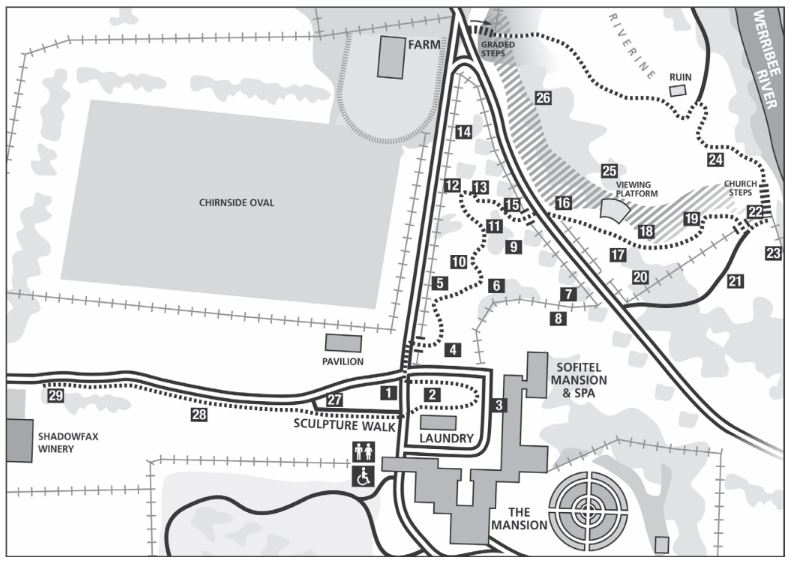
Sculptures include:
1. INNER Gary Deirmendjian, 2005
Inner is a monumental sandstone installation that aims to evoke and question the tensions between one's objective and subjective realities - the former striving for perspective and the latter for engagement. Sandstone is perhaps the most patient and humble of materials, formed simply of sand particles bound in a little clay and pressed under great sedimentary weight over hundreds of millions of years. It is absorbent, unable to be polished and responds to the slightest changes in moisture and light. It is considered a suitable metaphor by Deirmendjian for encapsulating the story of human arrival and its endangered virtues of humility and compassion.
2. THE COMRADE'S REWARD William Eicholtz, 2004
The Comrade's Reward takes the form of a traditional allegorical garden sculpture. This popular nineteenth century genre is reinterpreted in an eclectic and contemporary way as it deliberately references antiquity and unfashionable ideas of heroism and folly within a camp and knowing artifice. This work embraces solar technology and is fully self-contained, recharging during daylight hours and shimmering at night, surrounding and enchanting our comrade with fireflies or fairies - perhaps this is his reward?
3. ETHER Ari Purhonen, 2002
Ether embodies an optical effect produced by the natural phenomena of light. Rotating vertically around the axis, the illusion is created by an optical interference pattern within the sculpture; this optical energy alludes to energies and processes that drive organic growth. These energies are akin to the hypothetical ether, a massless medium that scientists once believed filled space.
4. DEATH OF A WHITE GOOD Alexander Knox, 2005
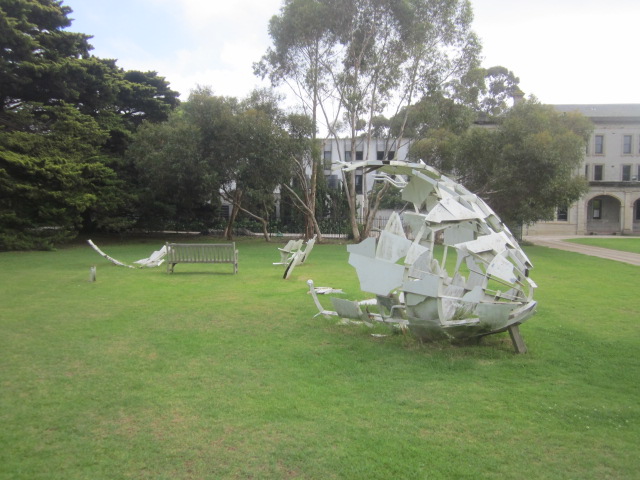
Far from the chaos of an airline crash Death of a White Good is a picturesque ruin. It is unclear if seconds or millennia have transpired since the crash. As with the shipwrecks iconic place in art and literature, the plane crash is a reoccurring image in contemporary media. Whether it be caused by an act of God, human/mechanical error or malicious intent it has the same power to horrify and so in turn become romanticised.
5. AS WEEKS GO BY Laurens Tan, 2004
As Weeks Go By represents four weeks of time as they disappear before our eyes, including the opportunities built into each day as represented by randomly perforated cams. Tan says "We are all pre-occupied with time because we either waste or lament the passing of youth and opportunities; you will notice the lights of the present week are going faster and one of them is today, the fastest of them all."
6. MENISCII Julia Davis, 2007
Meniscii explores the perceptions of, and relationships between, objects, spaces and places. In particular the relationship between the earth and the sky. Eight convex mirror forms are recessed into the ground and capture a distorted view of the entirety of their surroundings. The images captured appear controlled by the surface tensions of the forms, creating small visual clearing spaces.
7. OSCILLOSCOPE (TRACE) Donna Marcus, 2007
Oscilloscope (Trace) is based on the electrocardiogram or ECG, a device that measures the electrical activity of the human heart. This activity is displayed on the screen of the oscilloscope and mapped in exquisite detail by a line known as "The Trace". The Trace moves and fades across the screen as it tracks the changing rhythm of life. Discarded domestic aluminium objects bear the traces of modern life. A tonne of saucepan lids, pudding bowls and other redundant objects reordered as an oscilloscope becomes a symbol of the changing movement of people and things - a 'heartbeat' of everyday life.
8. MEME Phin Murphy, Marie Sierra & Jim Sinatra, 2004
Look up into the gum tree located on the other side of the fence for a glimpse of Meme. Also placed within two other nearby gum trees, Meme subtly appears and reappears. The work is an act of selection, a recurring object/image, an idea that spreads if though of its own volition - in short, a 'meme'. A meme is a unit of cultural information, such as a cultural practice or idea, which is transmitted verbally or by repeated action from one mind to another. The work, distributed through one species of tree, operates as an object theme.
9. MEANWHILE....DOWN SOUTH IN TASMANIA Bob Jenyns, 2005
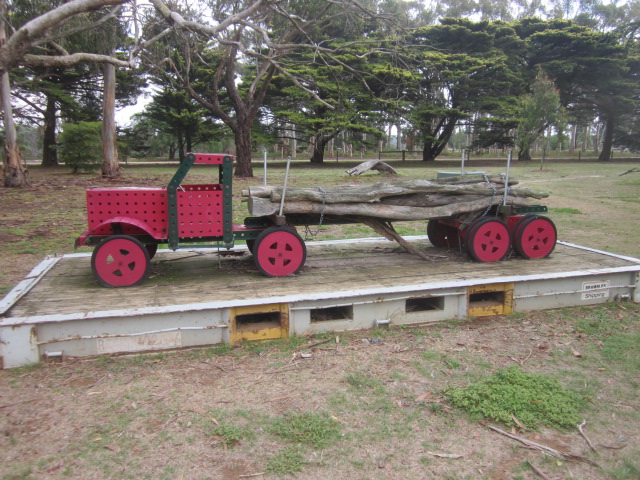
Meanwhile... down south in Tasmania explores the way in which aspects of history repeats itself, often in unexpected and ironical ways. The much loved Mennaco truck of childhood has become the real life nightmare of Jenyns' every day experience, with disturbing implications for current and future generations.
10. MIGRATION Ian Burns & John Clark, 2005
Migration is concerned with movement and the relationship between the individual components and the mass they represent in formation. Individually each component is evocative of man made objects, however en masse they begin to appear as natural elements. Progressively from the individual leader to the straggler at the back, there is a definite degradation of shape and form, suggesting disintegration over space and time.
11. HUT Karen Ward, 2000
Hut symbolises the house, the home, the shack, the cubby-house and the hermit's retreat. It also alludes to the potential to dream that is inherent within all of these structures, yet dreaming is only made possible by the Hut's inaccessibility.
12. FRACTAL CONSTRUCTION David Jensz, 2005
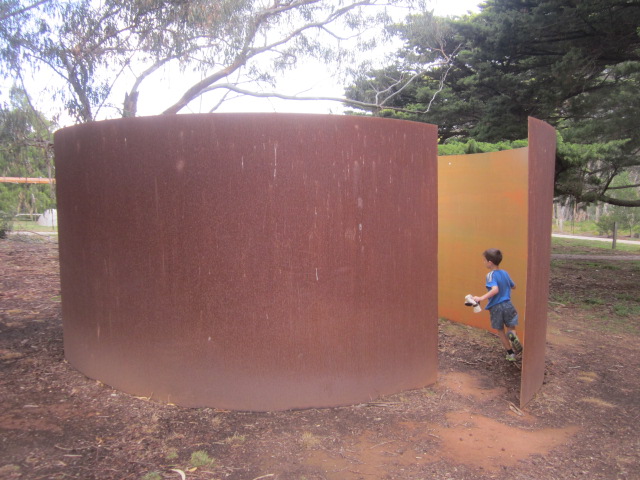
The curved form of Fractal Construction approximates the end of a massive pipe projecting from the ground. This recalls David Bohm's idea of "implicate order"; that information about the whole form is enfolded within the smallest fragment of it. Conceivably, the elbow joints may be made of a woven structure too small for us to see. Jensz says "I like to work with ideas that are yet to be proved and, while there is an element of fantasy involved, I enjoy playing with ideas that are speculative". This work was built on site over two weeks and Jensz was never sure how it would develop in the making.
13. PROSTHETIC APARTMENT B Richard Goodwin, 2004
Prosthetic Apartment B is an installation which creates a building within Werribee Park. As a site-specific work it brings the idea of habitation to a public park. Inscribed with the names of the 13 SIEV (Suspected Illegal Entry Vessel) boats, the work forms a monument to dishonour (much like the honour role boards in secondary schools) and dispossession of refugees.
14. PORTAL TO ANOTHER TIME AND PLACE Deborah Halpern, 2004
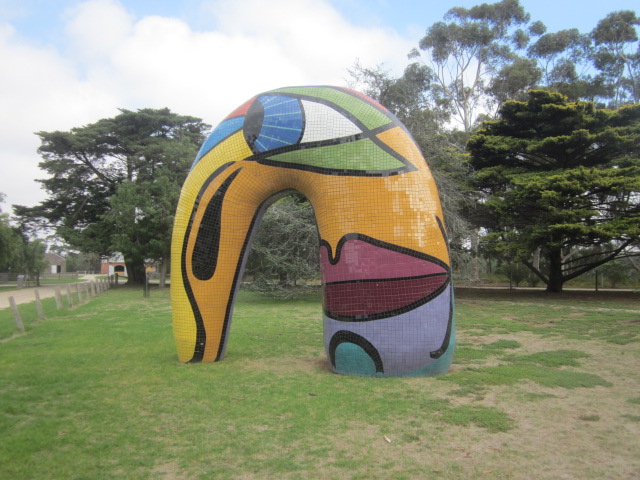
As related by Halpern, her work is "An arch in the shape of a face, leaning on its nose. To see something whimsical, surprising and delightful in the landscape is always inspiring". Halpern's most famous work is the bicentennial sculpture Angel that was located in the moat at the National Gallery in St Kilda Road, Melbourne.
15. HAPPY ENDING Nell, 2006
Happy Ending is a simple, curved arch, granite gravestone absent of text, epitaph or dates. With a face, personality and smile the bereavement and finality attached to a gravestone can flip joyously into the territory of serious humour and dark playfulness. The intentional naivety of the contented face communicates the last gesture of a simpleton. In the face of it all, arising from or sinking into the earth, good or bad, right or wrong, happy or sad is Thich Nhat Hanh's mindfulness mantra present moment, wonderful moment. Happy Ending says hello and goodbye to THIS moment and THIS life.
16. META-DIVA Nigel Helyer, 2002
Meta-Diva is an environmentally sound sculpture consisting of a group of thirty solar-powered units. Each unit contains a miniature digital audio chip that emulates an element of the natural soundscape, such as a birdsong, insect song or frog voices. The audio chips are set with a digital timer so that each of the thirty units has a unique time signature. The combination of multiple sound sources, individual time signatures and the fluctuations of the solar powered supply give the soundscape an uncannily natural presence.
17. SWARM Nigel Helyer, 2005
Swarm consists of a series of laser cut acrylic objects closely resembling microscopic marine forms, each supporting a solar powered digital circuit, amplifier and speaker. On approach the objects interact acoustically, with the entire sculpture acting as a 'swarm' of audio turbulence. Philosophically the work encompasses many networks of voices; the 'song-lines' of Australia's traditional owners, the frenzy of insect and bird communication and the technological communication links upon which we are so dependant. Swarm attempts a sonic-mapping of voices lost in the aether, of song long settled in the dust and inscribed into geological strata.
18. REMNANT Mike Taylor, 2004
A burnt gum tree gives Remnant its primary form but the work has much to do with historical allusions as natural forces. This gum tree remnant was built using a collection of discarded architectural masonry breeze-blocks which were shaped, moulded and reproduced in resin. Though the design of these blocks is modern, they strongly echo both Celtic motif and Islamic design traditions. They also allow free movement of air while maintaining visual privacy and act as a reminder of a time in which they were commonly used. It was a post-war time full of promise.
19. UPPERGROUND Ewen Coates, 2006
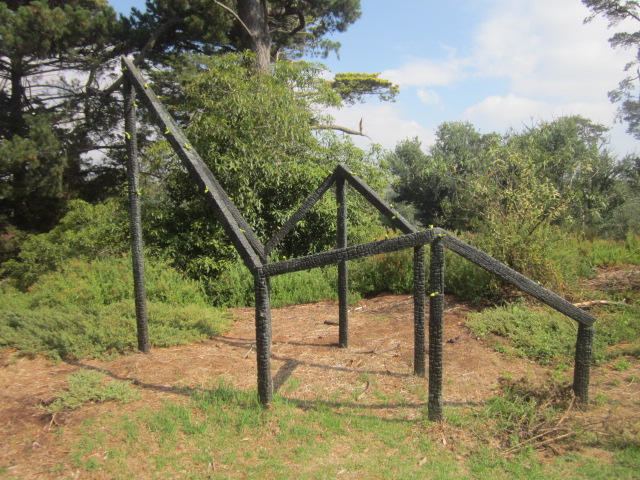
Upperground resembles a cathedral structure; raising questions about the relevance of the church and evolution of traditional teachings, in an era when religion causes schisms in our world. The burning of the structure encourages new foliage to grow over an old form. The foundations may stay roughly the same shape or evolve into something entirely new.
20. EXOSKELETON POD Richard Goodwin, 2000
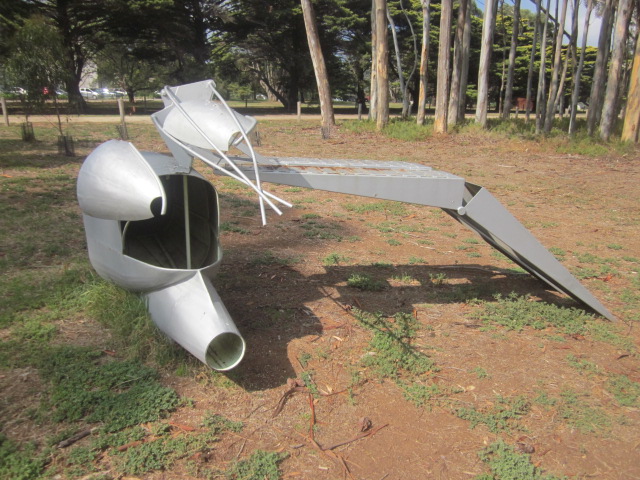
Exoskeleton Pod speculates about minimum architectures and the point at which the body stops and architecture begins. The forms used, hinting at the architecture of cars, planes and space junk (the discarded exoskeletons of the technological era) evoke images of insects and their spent carapaces which already litter the park at a different scale.
21. STEALTH II Gaye Roberts, 2006
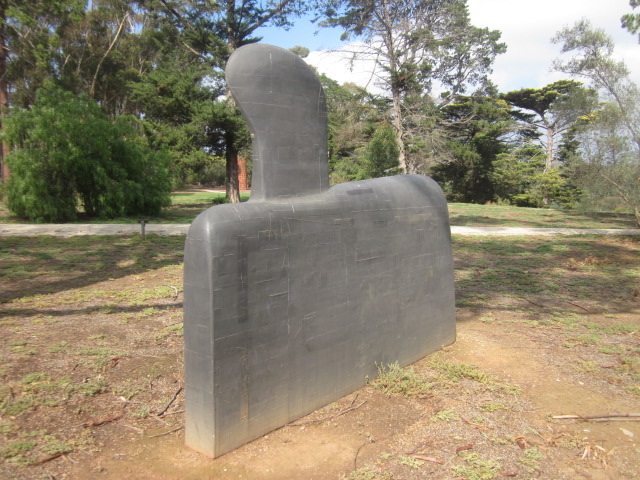
Stealth II is suggestive of a submarine. Submarines are handsome in their design and fine examples of how mankind has utilised the physics of the natural world. Yet they symbolise something which is sinister and unnerving. They create an unease, not only because their principle purpose is for destruction and subterfuge but also because they take people to places which are foreign and possibly dangerous. The concept for Stealth II came from an article in The New Scientist Magazine. Engineers funded by the US military are researching the possibility of implanting electrodes into the brains of sharks to control their movements. The Pentagon hopes to use the animals as stealth spies, exploiting their natural ability to glide through the water with little disturbance. Roberts feels that once again we are going to places which are foreign and dangerous.
22. ROTHKO'S CHAPEL Konstantin Dimopoulos, 2007
Rothko's Chapel is a dynamic sculpture exploring and expressing through colour, line and movement, the simple and reverential colour variations of renowned 20th century painter Mark Rothko's abstract palette of red against red. The optical effect of colour with movement on a vertical surface creates an energy that is suggestive of a mirage.
23. PASSAGE Fiona Orr, 2002
The concept of the frame has strong associations with history, painting and museums. Orr has been developing sculptural frames over recent years and is interested in taking the frame out of the gallery and placing it in the landscape. The scale, texture and colour of Passage encourages interaction, rather than being sited within a museum or gallery where the situation is "Do Not Touch". In this location Passage uniquely highlights the drama of African animals within Werribee Open Range Zoo.
24. WALL Mark Stoner, 2002-03
Wall is suggestive of great density and permanence; it is tough and uncompromising in its form - asserting itself within the landscape but remaining separate from it. Relating to the human condition, the scale is not overpowering but the mass is. To reach to the full height or width is impossible, but only just. Wall is a metaphor for life and nature and our existence as a moment within the continuum.
25. UNTITLED Gary Wilson, 2003
Wilson's Untitled promotes an expansive sensation from within the core of the work that contrasts strongly with the monolithic exterior. This piece has been described by the Helen Lempriere Award judges as juxtaposing a disquieting exterior with a high intensity walk-through interior.
26. BINARY Paul Hay, 2004
Binary is a work in two parts that operate as a singular piece. Each element has different aspects and colours that are identical in form. This work is non-representational and operates as a gestalt that relies on direct experience. There is no optimum viewing position and there are no hidden underlying structures.
27. MEANT TO BE Colin Langridge, 2005
Meant To Be is the result of developing the coopering process of wooden construction, where bent wooden laths are shaped to form hollow containers. Where wine casks employ a relatively gentle curve, this work has been taken beyond the circle. The overlap cerates an enticing gap that informs us we can never access the interior and similarly we can never fully know any object.
28. MOVING TOWARDS THE HEART Grant Finck, 2005
Moving Towards The Heart is made from steel and reinforced resin and described by Finck as follows: "Heliocentric Liquid Silica Crystal Bending Helicoid Torque Toward Halcyon Incarnate".
29. ZEPHYR Tim Edwards, 2005
Zephyr is a sculptural self portrait by Edwards. The interface of the human and the machine is a source of contemplation acting as a metaphor for production, aspiration and restriction. Zephyr is the continuation of a theme by Edwards whereby he situates himself as the work.
Photos:
Location
K Road, Werribee South 3030 View Map
✆ 13 1963
Email Enquiry
Web Links
→ Werribee Park Sculpture Walk - Park Note (PDF)








